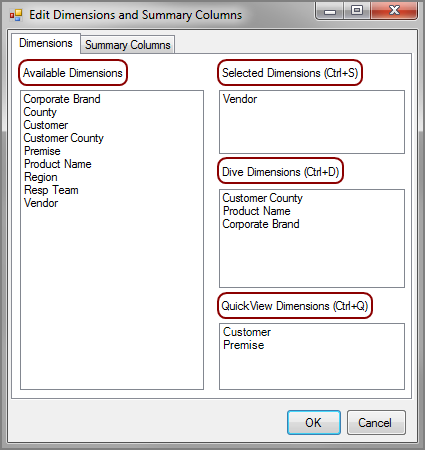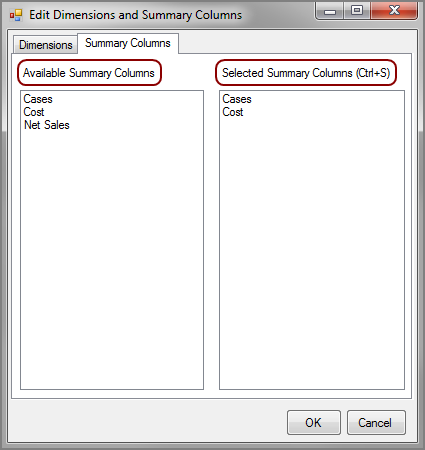An ad hoc page presents data from a cPlan in a predefined tabular format with dimensions on the left under a blue heading and summary columns on the right under a green heading.
Ad hoc pages give the user the ability to choose which dimensions and summary columns to display. Ad hoc pages also can switch dimensions and add or remove MultiColumns. The developer sets how the ad hoc page initially loads, and the user can then make changes in the client by choosing which dimensions and columns to display.
Ad hoc pages can use a dimension in several different ways:
- A standard dimension is used in all other page types and results in a list of dimension values for the dimension.
-
A dimcount-dimension is initially shown under a yellow column and are specific to ad hoc pages. They show a DimCount of the number of values that correspond to the dimension values.
NOTE: The dimcount-dimensions are called Dive Dimensions in DiveTab.
- A quickview-dimension is initially shown as a QuickView. They are specific to ad hoc and dive pages, while a dimension-quickview can be used by other page types.
- An available-dimension is not initially shown on the screen but can be added by the user within the application.
Additional dimensions that appear in the table by default are called dive dimensions, which are displayed under a yellow heading. Dive dimensions are initially displayed collapsed, but by clicking the arrow located in the heading, you can expand all dimcount-dimensions.
Ad hoc pages have summary columns, which can be initially visible or hidden or both. These columns can appear as text, alert, or bullet columns. Columns contained in an available-columns block are available to the DiveTab user to configure the page.
Examples
Here is a sample ![]() ad hoc page.
ad hoc page.
Here is how this sample ad hoc page ![]() appears in the code.
appears in the code.
Under the Options button (in the upper-right corner in the application), you can click the Edit button, which opens the Edit Dimensions and Summary Columns dialog box. This shows you all of the dimensions and summary columns available.
IMPORTANT: The Edit function is designed for individual and runtime use and is reset every time a user returns to the Main Menu or switches sections within a data area. This allows for various data combinations. For more permanent changes, edit the code to have the same layout for every use.
The DiveTab user can drag and drop items into different categories.
Here is an example of the ![]() Dimensions tab of the Edit Dimensions and Summary Columns dialog box.
Dimensions tab of the Edit Dimensions and Summary Columns dialog box.
Dimensions can be categorized as Selected Dimensions, or dimensions, under a blue heading, dive dimensions, or dimcount-dimensions, under a yellow heading, and QuickView Dimensions, or quickview-dimensions, under the page heading.
Here is an example of the ![]() Summary Columns tab of the Edit Dimensions and Summary Columns dialog box.
Summary Columns tab of the Edit Dimensions and Summary Columns dialog box.
The Available category includes all elements that are defined in the code. For the Available Dimensions, this means the dimensions, dimcount-dimensions, quickview-dimensions, and available-dimensions. For the Available Summary Columns, this means the summary columns defined for the page, including those within the available-columns block.
NOTE: Keep in mind that there must be at least one dimension under the Selected Dimensions category.


